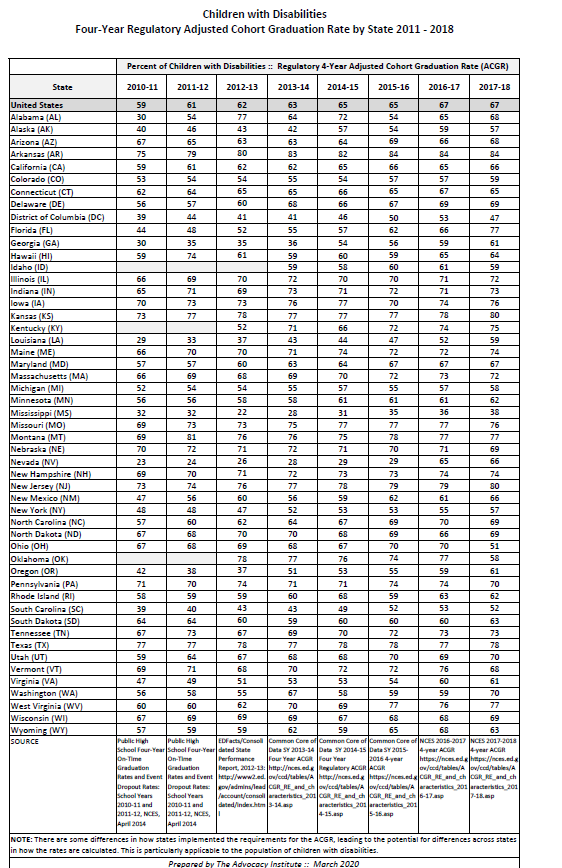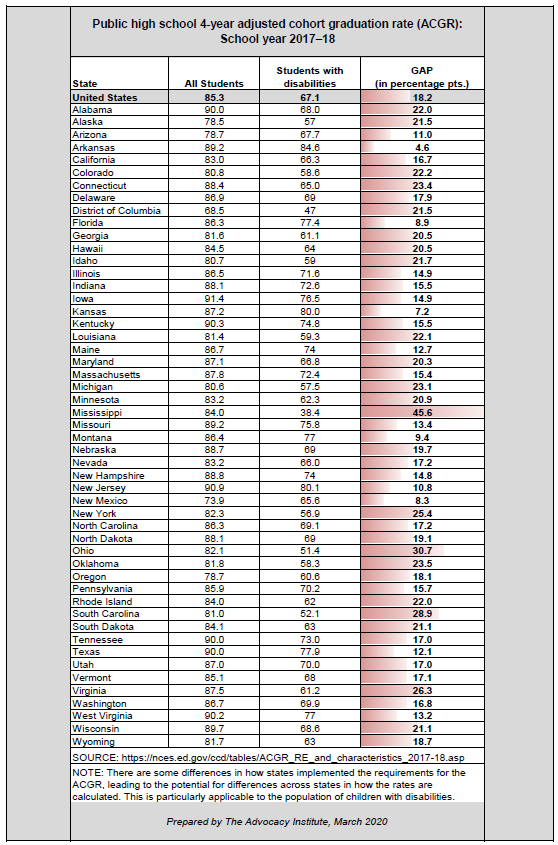State-by-State Graduation Rates for Students with Disabilities :: 2017-2018
States are required to report annually to the U.S. Dept. of Education (ED) the “4-Year Adjusted Cohort Graduation Rate (ACGR)” for all students and separately for many student subgroups, including students with disabilities. The 4-Year ACGR for the 2017-2018 school year was released on March 13, 2020.
ABOUT THE ACGR: The ACGR was put into place in 2008 via Federal regulations to help bring uniformity to the way states calculate the high school graduation rate. Reporting began with the 2010-2011 school year. The ACGR was subsequently included in the Every Student Succeeds Act (ESSA) passed in 2015. It is also the subject of non-regulatory guidance released by ED in January 2017.
States are to report only those students who graduated with a “regular high school diploma” in four (or fewer) years. ESSA defines a “regular high school diploma” as the “standard high school diploma awarded to the preponderance of students in a State that is fully aligned with the State’s standards.”
The ED guidance makes these important points regarding the ACGR for students with disabilities:
- A State may not include a recognized equivalent of a diploma as a regular high school diploma for the purpose of calculating the four-year or extended-year ACGR. (ESEA section 8101(43)(B)). Thus, students who graduate with a credential other than a regular high school diploma, such as a general equivalency diploma, modified diploma, certificate of completion, certificate of attendance, or a diploma based on meeting a student’s IEP goals, may not be counted in the numerator as having earned a regular high school diploma, but must be included in the denominator of the four-year and extended-year ACGR. (A-14, pg 13) A diploma based on meeting IEP goals will not provide a sufficient basis for determining that the student has met a State’s grade-level academic content standards; rather, it will only demonstrate that the student has attained his or her IEP goals during the annual period covered by the IEP. Therefore, a diploma based on attainment of IEP goals, regardless of whether the IEP goals are fully aligned with a State’s grade-level content standards, should not be treated as a regular high school diploma.(A-15, pg.13)
- States may count a student with the most significant cognitive disabilities who graduates with a State-defined alternate diploma in the cohort for a four-year ACGR within the time period for which the State ensures the availability of a free appropriate public education under section 612(a)(1) of the Individuals with Disabilities Education Act (IDEA)(A-16, pg.13)
However, because the U.S. Congress invalidated the Federal regulations governing accountability under ESSA, some issues regarding the calculation of the ACGR remain unsettled. These include:
- How states determine who is a “student with a disability” for inclusion in the subgroup. Therefore, states may be determining who is included in a variety of ways (started the cohort with an IEP, exited the cohort with an IEP, etc.) This lack of clarity impacts the comparability of the ACGR for students with disabilities across states.
- How states count students with the most significant cognitive disabilities who graduate with a State-defined alternate diploma in the four-year and extended-year ACGR. Therefore, states may be using different methodologies for this purpose.
In comparing ACGRs across states, the substantial differences in the requirements for a regular high school diploma used by states must also be taken into consideration. A 2017 report by the National Center on Educational Outcomes examined the diploma options, coursework and exit exam requirements for students with IEPs compared to those without IEPs. A regular high school diploma (as defined by ESSA) does not represent the same knowledge and skills across states nor does it necessarily indicate college and career readiness.
The ACGR plays an important role in the accountability plans that states are required to develop and implement required by ESSA. States must set long-term goals and measurements of interim progress for the ACGR, including by student subgroups.
While ACGR comparisons across states are difficult due to the issues discussed above, what is worth scrutiny is the GAP between students with disabilities and all students on the 4-year ACGR within each state. The table below provides the GAP for 2017-18 by state. (Keep in mind that the GAP would be larger if it were possible to compare students with disabilities to those without disabilities.)
Gap between all students and students with disabilities 2017-18 ACGR by state:
Download this chart (PDF)
The chart below shows the performance of students with disabilities over the eight years since ACGR reporting began.

Download this chart. (PDF)
NOTE: States reporting an ACGR more than 5 percentage points different (higher/lower) than the prior year for any subgroup are asked to provide an explanation for the increase/decrease to ED. Below are the explanations provided to ED by states with substantial increase/decrease in their ACGR for students with disabilities from 2016-17 to 2017-2018 (excerpted from the ACGR Data Notes at https://www2.ed.gov/about/inits/ed/edfacts/data-files/index.html#acgr). LEA and school level ACGR data are also available.
District of Columbia (-6): DCPS reported a lower graduation rate in SY 2017-18 compared to SY 2016-17; this change drove much of the observed state-level changes as DCPS students comprise approximately half of all DC students.
Florida (+11): The data reflect ongoing efforts by Florida to raise its graduation rate across all subgroups.
Louisiana (+7): Louisiana has shown growth in the overall state grad rate and made significant strides with these specific subgroups. In general, Louisiana’s overall cohort graduation rate increased over this period, with subgroups outpacing the average. In particular, Louisiana has increased its support and resources for high schools to serve historically disadvantaged groups of students.
New Mexico (+5): State indicated that data were correct as reported.
Ohio (-19): A change in business rules – due to ESSA – regarding the assignment of students to the HOM, LEP and CWD subgroups changed in SY 2017-18. These subgroups became an “if ever” subgroup in SY 2017-18 changing from a student’s status as of graduation as in previous years. This change in business rules affects the number of students both counted as graduates and non-graduates which resulted in changes to the subgroups graduation rate.
Vermont (-8): No response
Washington (+11): No response
Wyoming (-5): No response
See also:
State-by-state Graduation Rates for Students with Disabilities:
2016-2017
2015-2016
Diploma Options, Graduation Requirements, and Exit Exams for Youth with Disabilities: 2017 National Study (National Center on Educational Outcomes, 2019)
Diplomas that Matter: Ensuring Equity of Opportunity for Students with Disabilities (Achieve, 2016)
Almost all students with disabilities are capable of graduating on time. Here’s why they’re not (Hechinger Report, 2017)
Graduation Issues and Considerations for Students with Disabilities Webinar presented by The Advocacy Institute and the National Center on Educational Outcomes (archived recording) Webinar Handout (PDF)
Diplomas at Risk: A Critical Look at the Graduation Rate of Students with Learning Disabilities (2013)
